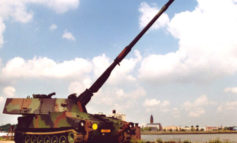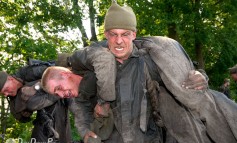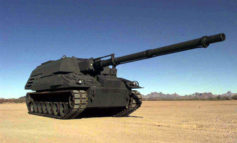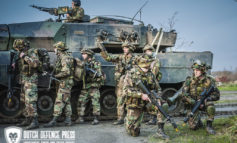King of Battle: The Field Artillery (FA) mission is to destroy, neutralize, or suppress the enemy by cannon, rocket and missile fire and to help integrate all fire support assets into combined arms operations. The FA battalion is one of the most synergistic units in a brigade combat team. Its devastating fires can have a truly destructive effect on the enemy when it is synchronized with the other members of the combat team. Within it, the sum of its several individual crews is what produces this devastation, provided it has trained on the basics and can synchronize these crews to provide timely and accurate fires. The branch has witnessed significant changes in training requirements and methodologies as weapons systems and operational environments changed. The days of march, order and 10 to 20 minute emplacement and ready-to-fire times are history. Today’s Self Propelled (SP) Guns like PzH2000, AS-90 and the M109A6 ‘Paladin’ can travel and stay in close proximity to manoeuvre battle formations. The operations tempo of an orders process doesn’t allow for a “learn as you go” method. There was a need to educate manoeuvre and fire supporters and the FA to fight as a manoeuvre system using indirect fires. This to continue as the “Greatest Killer on the Battlefield” for the 21st century and too ensure the FA remains the “King of Battle”.
Centres of excellence: One goal that FA training centres (FATC) around the world has in common, is training crews on basic tasks to ensure that when their combat team needs them, they are there trained and ready. One of those centres of excellence with a long legacy of service in providing professional competencies to FA men and woman is the FATC located at Fort Sill, Oklahoma in the USA. With its design of one-station unit training, it simultaneously trains and builds a cohesive team.
Howitzer Crew training: Howitzer crews are the part of the battalion that actually produces the effects on target. Training these crews, has been around the longest and is probably the best understood. For this the FATC has its gunnery team trainer, developed by L-3 Communications “Link Simulation & Training Division”. Knowing the fire support combined arms tactical trainer (FSCATT), which took training to a new level. It is a working replica of an M109A5 or A6 howitzer to train 155-mm SP howitzer crew, fire direction centre (FDC) personnel and forward observers (FO) to enhance their mission skills while practicing delivery of simulated munitions in a highly realistic battle environment. The 1st Battalion, 78th Field Artillery, is using such a howitzer crew training bay. In this facility new cannoneers are first introduced to crew drill. The bay has six of these howitzer crew trainers (HCT), two of them known as Guard unit armoury device full-crew interactive simulation trainers (GUARDFIST II) for FO and six sets of FDC support systems (FDCSS). The FDCSS allows FDC personnel to train in the stand-alone mode, simulating the howitzer and the FO. The FDCSS will interface with actual FDC hardware in the platoon and with the M109A5 or M109A6 howitzers, the latter in the interactive or closed-loop training modes.
Training modes: FSCATT can accomplish the training in three separate modes. In the stand-alone mode, each component conducts training independently. In the inactive mode, two of the components are linked. In the closed-loop training mode, all three components interact and training is conducted as a gunnery team on every type of fire mission. The “bedrock” for the FSCATT system is the HCT that replicates the firing of a real howitzer all the way down to the cant and recoil. For an adjust-fire mission with an M109A5, the FO identifies a target and sends a call-for-fire to the FDC. The FDC processes the mission and transmits the firing data to the HCT. For an adjust-fire mission with the M109A6, the HCT computes its own firing data with its automatic fire control system (AFCS). The M109A6 also can perform degraded tasks in both the stand-alone and interactive modes. The degraded tasks simulate the loss of the AFCS, forcing the crew to manually set the firing data computed by the FDC. The HCT requires the crew to select the appropriate shell, fuze and propellant combinations; lay the howitzer for deflection and quadrant, ram the round, and fire it. The section chief must ensure the appropriate commands are used and proper ammunition is loaded and fired. The gunner has a synthetic sight allowing him to use a collimator, aiming posts or a distant aiming point, depending on the training scenario. The assistant gunner must ensure the quadrant is set properly. All bubbles must be level. If the steps are not completed properly, mistakes will be reflected on the after-action review (AAR). The FDCSS is wired to the lightweight computer unit (LCU). It comes equipped with several training scenarios or the instructor can create its own. The system causes the FDC to respond to a large number and variety of fire missions and can act as both the observer and the howitzer, providing real-time data to the FDC in the stand-alone mode. GUARDFIST II provides the FO training portion of FSCATT. It is a computer-based trainer that uses virtual (three-dimensional) terrain. The observer identifies a target and sends a fire mission using a forward-entry device (FED) or by voice to the FDC, which forwards the submission to the HCT. Rounds are fired by the HCT, the impact is displayed on the screen and the observer follows the usual adjustment procedures.
Performance Feedback: The recording and scoring of all activities in the HCT brings a new dimension to training. The system automatically scores eight items for the AAR: deflection, quadrant elevation, bubble level, projectile, propellant, fuze and fuze settings, aiming points and mission time. In addition, an instructor-operator station (IOS) is positioned so the operator can monitor all the crew’s activities inside the turret via cameras and microphones mounted inside. The ammo handlers are observed and graded by the instructor, who manually inputs data into the AAR database.
Ammunition and Fuzes: The system is fielded with all the projectiles, powders and fuzes units reasonably can expect to fire in combat: 14 types of projectiles, 12 types of fuzes and six charges. A total of 39 projectiles, 39 fuzes, 40 reusable simulated M82 primers and 44 simulated charges with shipping canisters are included. This permits realistic and continuous training of tasks involving ammunition preparation and handling. Soldiers can repeatedly practice crew drills to fire ammunition and fuze combinations they’ve never fired before. FSCATT does not require a special range to fire special munitions, such as dual-purpose improved conventional munitions or other expensive munitions. And FSCATT ammunition is “recycled”; units will never run out of ammo. The majority of training is done on the HCT. The facility can train 60 soldiers at one time in the HCTs and, simultaneously, an additional 120 soldiers in classrooms on ammunition handling. In this era of reduced resources and manpower, FSCATT is instrumental in keeping FA men trained and ready
Air defence training programme: Many armed forces have realized it needs to speed up some acquisitions of training aids, devices, simulators and simulations (TADSS). The Royal School of Artillery (RSA) at Larkhill in the United Kingdom is another centre of excellence that benefits from that point of view. Primary Image, has recently supplied through Thales Air Defence, image generators for the training system for its highly successful High Velocity Missile (HVM) to upgrade the existing part task Starstreak trainers for the British Army. They have successfully been implemented into the air defence training programme and have already been used for training the Royal Marines. Primary Image has provided a number of configured PCs using its P10+ graphics board which is capable of providing highly realistic photographic imagery making it ideal for optically guided missile systems. As realistic imagery is critical to improving tracking skills, Primary Image will be replacing the existing IG technology and will be providing the visual simulation for the shoulder launch missile trainer, the light missile launcher trainer and the self-propelled missile trainer. Previously, students had to make do with black and white graphics with some basic targets. Now students using the HVM trainers can make the most of P10+’s photographic backgrounds, which adds enormously to the realism. Students also have a variety of backgrounds to choose from in order to prepare them for different terrains and environments as well as the ability to generate their own scenarios. Another advantage of P10+ is the ability for the student to be able to recognise different 3D targets. This now allows the student to recognise the exact type of target it is faced with.
The RSA recognised the benefits of simulation to deliver the ability to train both continually and cost effectively. The HVM Trainer systems delivered continue to demonstrate a 100% reliability record and wide user acceptance. Additional systems have been supplied to the Artillery Regiments for continuation training. Since taking delivery of the HVM Trainers, Captain Paul Guy, Technical Instructor Gunnery (Air Defence) testifies: “The HVM Trainers are a leap forward in technology and graphics and we have noticed a significant improvement in live firing results. The photographic backgrounds in particular have provided a level of realism for the students, which previously would not have been seen on such a simulator. “Sergeant Marc Davies, Regiment Instructor added, “For once, students are keen to use the trainers as the graphics are so realistic. This enthusiasm is essential as it means that students are happy to keep practising until they reach a certain level. By using the HVM Trainer, operators can practise firing as many times as is necessary before they complete the training course. In total each student must successfully complete 700 shots on different levels before going on to fire on a live range. By the time the students arrive at the live fire range, the training they received on the HVM trainer has meant that so far students have not missed a single target, therefore significantly reducing the costs to the British Army.”
TADSS has become a necessity in realistic training. Simply by the fact; many armed forces don’t have enough time to conduct all the training it need for maximum preparedness. For example, small unit individual and crew-served simulators allow soldiers to run scenarios over and over, building confidence with marksmanship and the experience one needs for rapid decision making in combat. Without simulations, training scenarios over and over to give soldiers a wide array of experience is very expensive and labour-intensive. Not to mention they also lack the time or range space.











Leave a Reply